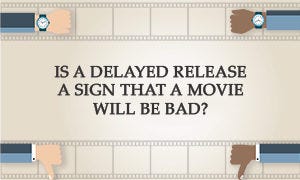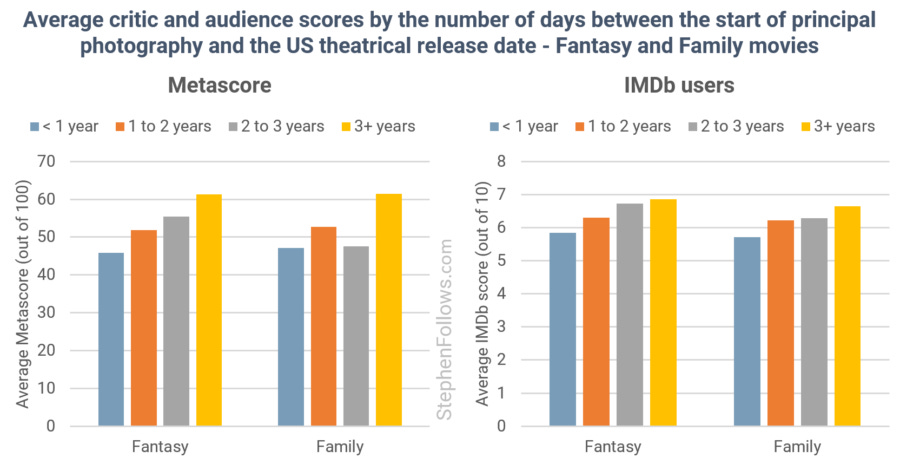Is a delayed release a sign that a movie will be bad?

X-Men: Dark Phoenix opened in cinemas a few weeks ago - a release date which is significantly later than first intended.
The film's director, Simon Kinberg, blamed the delayed release on a few factors, including the complexity of the film's visual effects. Said Kinberg:
When we felt like we weren't going to be able to complete the movie to the level we wanted to complete it from a visual effects standpoint, we considered moving it from November [2018] to February [2019]. Then, because of the way the international calendar was for us and how fast we could get materials to other territories, we felt like February became not just challenging, but not necessarily the best window internationally for the film.
Dark Phoenix started shooting exactly two years ago (at the time of writing), meaning that there were 709 days between the first day of principal photography and its theatrical release.
This feels like a long time. But how does it compare to Hollywood's average movie?
And if a future movie is similarly delayed, should we take this as an indication that it's not going to be very good? Let's take a look.
How long between a movie's shoot and its release?
I built a dataset of filming dates (where publicly available) for all Hollywood movies released in the twenty years between 1999 and 2018. I found suitable data for 1,905 movies (you can read details of my sources and methodology at the end of the article).
By counting the number of days between the first day of principal photography and the US theatrical release date, we get what I'm calling the 'Shoot-to-screen' value, measured in days. For example, the first X-Men movie starting shooting on 22nd September 1999 and reached US cinemas on 14th July 2000, giving it a shoot-to-screen value of 296 days.
Across all the films I studied, the average shoot-to-screen value was 475 days. However, this differed considerably depending on genre.
Sports and music-based movies were the quickest (412 and 422 days, respectively) and Fantasy and Historical films look the longest (528 and 510 days, respectively).

Dark Phoenix took longer to reach cinemas than 90% of films released between 1999 and 2018.
How has this been changing over time?
My dataset spans a twenty year period over which the film industry moved from physical to digital technologies, both on set and in post-production. Therefore, one may be forgiven for thinking that movies make their way from shoot to screen quicker than they did two decades ago.
Not so.
In fact, the average 2018 release took 38% longer to reach cinemas than the average 1999 release (418 days versus 575 days).

This pattern is reflected across all genres, to varying degrees. Family films have slowed the most (2018 releases took 75% longer than 1999 releases) with Action films showing the least change (just 17% longer).

How does the delay relate to the film's quality?

The critical drubbing Dark Phoenix has received has been reflected in the box office, with both film critics and audiences scoring the movie poorly. Many reviews mention the delayed release dates as if this somehow explains or predicts that the movie would be bad.
We can test this theory by correlating the 'Shoot to Screen' value with two measures of quality:
Metascore, which is a weighted average of the ratings given by top film critics, as calculated by Metacritic, expressed as a value out of 100.
IMDb audience rating, which is the score given by IMDb users, expressed as a value out of 10.
Most genres did not show a statistically significant correlation (i.e. a Pearson correlation coefficient of below -0.2 or above 0.2, where 1 would be perfectly positively correlated and -1 would be perfectly negatively correlated) but four did.
Two genres showed a significant negative correlation, meaning that the longer the movie took to reach cinemas, the worse it was. They were Biographical and Historical films.

The reverse is true of two other genres - Fantasy and Family movies. These genres have a statistically significant positive correlation between the time it takes to get to the screen and its ratings. In short - the longer they take, the better they are.

IMDb classifies Dark Phoenix in three genres; Action, Adventure and Sci-Fi - all genres which do not, on average, show a link between delays and poor quality.
So we cannot cite Dark Phoenix's delays as proof of it being a bad movie. For that, we will need to just rely on the script, pacing, acting, lack of meaning or the overall absence of anything original.
Related topic
I looked at related topics about a year ago, in an article entitled How long does the average Hollywood movie take to make? In that piece, I investigated a smaller dataset of movies, but also found dates for announcing, pre-production and post-production.
Notes
The data came from a large number of sources including IMDb, Wikipedia, NATO, The Numbers, Deadline, Variety, Hollywood Reporter, New York Times and the websites of filmmakers and film companies. This study looks at live-action, fiction, feature films designed for a commercial theatrical release. Therefore, I excluded other film types such as animation (i.e. The Good Dinosaur), documentaries (i.e. Shine A Light), IMAX short films (i.e. Hubble 3D) and concert movies (i.e. Glee: The 3D Concert Movie). Genres used were the ones assigned by IMDb.
About a fifth of the raw data for today's research was gathered by students on the MA Film Distribution and Marketing course at Birmingham City University. Their tutors, Pip Piper and Eugenio Triana, reached out to me a couple of years ago and proposed that I set the students film data research projects. I jumped at the chance to have such knowledgeable, smart students help out and the end result is four projects which I’ll be sharing on the blog over the next few months. So a BIG thank you to Kara Hanna, Anthony Evans, Corinna Osei and Yu Wang for all their hard work and research on this week’s topic.


